Overview
- Brief Narrative
- Anti-Jewish and anti-American Nazi propaganda leaflet resembling a US dollar bill brought back from the war by Harold Goldberg, an American soldier who served in Europe, circa 1945-1946, during and after World War II. This type of leaflet was dropped from planes over Paris in late 1943, as part of a German propaganda campaign to raise suspicions against the United States and its part in the worldwide Jewish conspiracy which threatened the safety of France and all of Europe. The streets would appear to be littered with real dollar bills. After picking one up, a person would discover that it was fake and read about how Jews have manipulated the US and controlled its currency to wage the Jewish war.
- Date
-
found:
approximately 1945-1946
- Credit Line
- United States Holocaust Memorial Museum Collection, Gift of the family of Harold Goldberg
- Markings
- front, top border, white on black background : ONE SILVER CERTIFICATE ONE
front, below border : D THIS CERTIFIES THAT THERE IS ON DEPOSIT IN THE TREASURY OF / THE UNITED STATES OF AMERICA
front, each corner, black ink : 1
front, bottom border : ONE DOLLAR / IN SILVER PAYABLE TO THE BEARER ON DEMAND
front, over denomination on left : THIS CERTIFICATE IS LEGAL TENDER / FOR ALL DEBTS, PUBLIC AND PRIVATE
serial number, front, lower left corner, blue ink : Y91033384 A ; front, lower left : W.A. Julian / Treasurer of the United States ; lower right : SERIES 1935A ; Henry Morgenthau Jr. / Secretary of the Treasury
inside left : Le Ministre du Tresor des États-Unis est le Juif MORGENTHAU junior,/apparenté aux grands requins de la Finance internationale./Tous les attributs juifs figurent sur ce dollar:/L'Aigle d'Israël/-Le Triangle-/L'OEil de Jéhovah/13/lettres de la Devise/étoiles de l'Auréole/flèches/rameauz d'olivier/marches de la Pyramide inachevée/Cet Argent est bien Juif! [The Minister of Finance of the United States is the Jew Morgenthau Jr., related to the great sharks of international finance. All of the Jewish attributes figure on this dollar. The Israel Eagle; The Triangle; The Jehovah's eye; 13; the letter of slogan; the stars of success; arrows; olive branches; the steps of the unfinished Pyramids.]
center, yellow Star of David with printed message in center : Ce dollar ne veut que s'il est signé MORGENTHAU. [This dollar is worth nothing if it is signed Morgenthau.]
inside, on left and right sides, black ink : CE DOLLAR A PAYÉ LA GUERRA E JUIVE / Seul message que les Anglo-Américains sont en état de nous adresser, / suffira-t-il à nous dédommager des malheurs que nous vaut / ----- LA GUERRE JUIVE? ----- / L’Argent n’a pas d’odeur... / MAIS LE JUIF EN A UNE! [This money is certainly Jewish! This dollar has paid for the Jewish war. The only message that the Anglo-Americans are able to address to us is: Will this dollar be enough to compensate us for the sorrows caused by the Jewish war? Money has no smell...but the Jew has one!] - Contributor
-
Subject:
Harold B. Goldberg
- Biography
-
Harold B. Goldberg (1922-2011) was born in Brooklyn, New York to Samuel and Rose Goldberg. Samuel and Rose were born in Russia and immigrated to the United States before the birth of their children. Samuel worked as a presser in a tailor shop. Harold had six siblings and the family spoke Yiddish and English at home. As a young adult Harold worked as a mail carrier and attended City College in New York. On December 7, 1941, Japan bombed Pearl Harbor. The following day the United States declared war on Japan, and on December 11, Germany declared war on the United States. On October 31, 1942 Harold was drafted into the U.S. military. He entered the army on October 31, 1942 as a private, and received serial number 32613738. He served in Europe until the end of the war. Harold then returned home to New York where he married his wife Rita in 1952. The family lived in New York for the rest of their lives.
Physical Details
- Classification
-
Information Forms
- Category
-
Fliers
- Object Type
-
Leaflets dropped from aircraft (lcsh)
- Physical Description
- Bifolded, rectangular offwhite paper leaflet in black and green ink mimicking a United States one dollar silver certificate. The face has a black decorative border with corner medallions with the denomination 1. There is a portrait of George Washington in the center; to the left is a denomination 1 underprint, serial number Y91033384 A in blue ink, series 1935A, and engraved signatures. The back cover has a green web patterned border. On the left and right are images of the front and back of the Great Seal of the US: front, an unfinished pyramid topped by the Eye of Providence within a triangle; back, an eagle with outstretched wings and a shield. The denomination ONE is in the center and 1 is in the 4 corners. The interior has a yellow Star of David, with text within, printed across the center fold, with text to the left and right.
- Dimensions
- overall: Height: 2.625 inches (6.668 cm) | Width: 6.125 inches (15.557 cm)
- Materials
- overall : paper, ink
Rights & Restrictions
- Conditions on Access
- No restrictions on access
- Conditions on Use
- No restrictions on use
Keywords & Subjects
Administrative Notes
- Legal Status
- Permanent Collection
- Provenance
- The propaganda leaflet was donated to the United States Holocaust Memorial Museum in 2013 by the family of Harold Goldberg.
- Funding Note
- The cataloging of this artifact has been supported by a grant from the Conference on Jewish Material Claims Against Germany.
- Record last modified:
- 2022-08-11 11:11:50
- This page:
- https://collections.ushmm.org/search/catalog/irn84853
Download & Licensing
In-Person Research
- By Appointment
- Request 21 Days in Advance of Visit
- Plan a Research Visit
- Request to See This Object
Contact Us
Also in Harold B. Goldberg collection
The collection consists of artifacts: armbands, a badge, a leaflet, military insignia, a pennant, a ring, and scrip relating to the experiences of Harold Goldberg as a soldier in the United States Army in Europe during World War II.
Date: 1907-1946
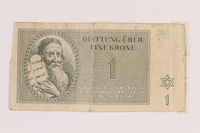
Theresienstadt ghetto-labor camp scrip, 1 krone note, acquired by a US soldier
Object
Theresienstadt ghetto scrip, value 1 krone, brought back from the war by Harold Goldberg, an American soldier who served in Europe, circa 1945-1946, during and after World War II. Scrip of this type was issued in Theresienstadt ghetto-labor camp in the Protectorate of Bohemia and Moravia in German annexed Czechoslovakia. All currency was confiscated from internees upon entry. The scrip, dated January 1943, but first distributed in May, was for use only in the camp. There was little to exchange it for, other than library book rental. The notes created an illusion of a normal, functioning community. But living conditions were terrible, with death due to starvation, disease, or deportation constant threats. Theresienstadt (Terezin) camp existed for 3.5 years, from November 24, 1941, to May 9, 1945, when it was liberated by Soviet troops.

Small Nazi Party Rally banner with an image of Hitler acquired by a US soldier
Object
Small Nazi Party red cloth banner with an image of Adolf Hitler brought back from the war by Harold Goldberg, an American soldier who served in Europe, circa 1945-1946, during and after World War II. The banner was made for the September 1934, 6th annual Nazi Party Rally in Nuremberg, Germany.

Yellow armband embroidered Deutsche Wehrmacht for use by laborers acquired by a US soldier
Object
Deutsche Wehrmacht (German Army) yellow armband brought back from the war by Harold Goldberg, an American soldier who served in Europe, circa 1945-1946, during and after World War II. This armband was worn by German civilians and foreign workers employed by the German Armed Forces.
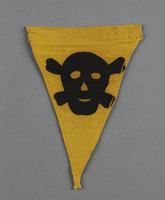
Small, yellow warning pennant with a skull and crossbones acquired by a US soldier
Object
German military issue, poison gas warning pennant brought back from Germany by Harold Goldberg, an American soldier who served in the European Theater in 1945. The pennants were attached to a thin, iron rod and staked into the ground. They were used to mark off areas contaminated with dangerous gas, and later repurposed to warn against hidden landmines. The pennants were part of a set that included 20 flags, each attached to a 60-cm-long iron rod, painted with red anti-rust paint, a roll of yellow tape, and a carrying pouch. Harold B. Goldberg lived in New York City, where he attended City College and worked as mail carrier prior to being drafted into the U.S. Army as a private, in October 1942. Harold served in Europe until the end of the war and then returned to New York, where he married his wife Rita in 1952.
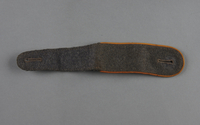
Wehrmacht shoulder board in gray with gold trim acquired by a US soldier
Object
German Army uniform gray felt shoulder board with yellow gold piping brought back from the war by Harold Goldberg, an American soldier who served in Europe, circa 1945-1946. This is the type of epaulet worn by enlisted men, most likely in cavalary and reconnaissance units, in the Wehrmacht.

Luftwaffe officer's insignia with embroidered silver wire eagle and swastika acquired by a US soldier
Object
Luftwaffe officer's insignia patch with an embroidered silver bullion thread flying eagle and swastika brought back from the war by Harold Goldberg, an American soldier who served in Europe, circa 1945-1946, during and after World War II. It would be placed on the front crown of an officer's hat or above the right breast pocket of a jacket.
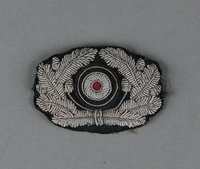
German Army officer's visor cap insignia with a silver wire oak leaf wreath and cockade acquired by a US soldier
Object
German Army officer's visor cap badge with a silver bullion wreath and red centered cockade brought back from the war by Harold Goldberg, an American soldier who served in Europe, circa 1945-1946, during and after World War II.
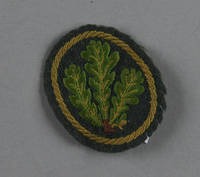
German Army, Jager Regiment, Brandenburg Division, sleeve insignia with embroidered oak leaves acquired by a US soldier
Object
German Army dark green wool badge with a spray of oak leaves brought back from the war by Harold Goldberg, an American soldier who served in Europe, circa 1945-1946, during and after World War II. The patch was worn on the upper right sleeve by Jager (light infantry) Regiments, Panzer-Grenadier Division, known as the Brandenburg Division. For most of the war, this was an elite commando unit specializing in saboteur campaigns. In July 1944, several Division members were implicated in the failed assassination plot on Hitler. It was redesignated as a conventional unit and sent into action on the Eastern Front in December 1944, where the German Army was collapsing under the Soviet advance.
Harold B. Goldberg photographs
Document
Contains nine photographs brought home from World War II by Harold Goldberg following his service with the US Army. Most of the photographs depict an unidentified concentration camp, including images of a gas chamber and crematoria. One postcard photograph depicts Adolf Hitler and Paul von Hindenburg at a ceremony at the Tannenberg memorial, 1934.
Star of David badge printed with Jude for Jew acquired by a US soldier
Object
Star of David badge, with signs of use, printed with the German word Jude for Jew brought back from the war by Harold Goldberg, an American soldier who served in Europe, circa 1945-1946, during and after World War II.
German State criminal police and a Gestapo warrant badge on a chain acquired by a US soldier
Object
Two warrant discs [Dienstmarken], silver for the Gestapo [Geheime Staatspolizei], the secret state police, and bronze for the State criminal police [Kriminalpolizei] in Nazi Germany brought back from the war by Harold Goldberg, an American soldier who served in Europe, circa 1945-1946, during and after World War II. After Himmler centralized the police forces in the German Reich in the mid-1930s, these became the official identification badges for the Gestapo and the state criminal police. They are stamped with individual officer's numbers and were generally suspended from a chain. They had the authority of a warrant and once displayed during an arrest, investigation or search, ensured compliance.
NSV, National Socialist People's Welfare Organization 1938 membership badge acquired by a US soldier
Object
National Socialist (Nazi) People's Welfare Organization [NSV: Nationalsozialistische Volkswohlfahrt] 1938 lapel pin badge brought back from the war by Harold Goldberg, an American soldier who served in Europe, circa 1945-1946, during and after World War II. The NSV began in 1932 as a local welfare organization and mainly provided money to poor, deserving families in Berlin. This was a forceful propaganda tool for the Nazi Party which soon centralized and administered the NSV. By 1938, it was one of the largest organizations in Germany. It offered child care, health, and medical services, and promoted Nazi family and population policies. The annual fundraising campaign was a major event throughout Germany.
2 place ribbon bar, War Merit Cross 2nd class with swords and Eastern Front ribbons acquired by a US soldier
Object
German bar pin with 2 ribbons: War Merit Cross 2nd class with crossed swords pin [Kleine Ordensschnallen] and an Eastern Front ribbon (Ostmedaille] brought back from the war by Harold Goldberg, an American soldier who served in Europe, circa 1945-1946, during and after World War II. The War Merit Cross 2nd class with swords was awarded after 1939 to military personnel for bravery, though not necessarily in combat. The Eastern or Russian Front medal, introduced on May 26, 1942, was awarded to participants of the first winter campaign of Operation Barbarossa, the invasion of the Soviet Union launched in June 1941.
75th anniversary pin for the Fire Department of Ladenburg acquired by a US soldier
Object
Tinnie commemorating the 75th Anniversary of the Fire Department of Ladenburg in Bavaria, Germany, brought back from the war by Harold Goldberg, an American soldier who served in Europe, circa 1945-1946, during and after World War II. It displays the department's medieval helmet and ax emblem joined with a swastika.
WWII German Army General Assault badge with an eagle on an oak leaf wreath acquired by a US soldier
Object
Wehrmacht General Assault badge with the cutout of an eagle with retracted wings on an oak leaf wreath brought back from the war by Harold Goldberg, an American soldier who served in Europe, circa 1945-1946, during and after World War II. The badge was instituted by General von Brauchitsch on June 1, 1940, as an award for soldiers who took part in 3 separate combat actions on different days, and was not eligible for infantry or armored assault badges.
Schwabisch Hall red, gold and blue enameled coat of arms pin acquired by a US soldier
Object
Schwabisch Hall cross and hand crest lapel pin brought back from the war by Harold Goldberg, an American soldier who served in Europe, circa 1945-1946, during and after World War II. Schwabisch Hall is a town in Baden-Wurttemberg state in southern Germany, midway between Stuttgart and Nuremberg. In 1936, the Luftwaffe established an airport in the Hessental section. It was destroyed by Allied bombardment in September 1944. The Germans immediately began re-construction and a subcamp of Natzweiler-Struthof concentration camp, called Schwabisch Hall- Hessental, was built to supply labor. On April 5, 1945, as the Allies neared, the camp was evacuated by death march to Dachau. Schwabisch Hall was occupied by US troops on April 17, 1945.
Tri-color aluminum cockade with twisted rope circles for a Rural Police shako acquired by a US soldier
Object
Schutzpolizei [Protection Police] shako aluminum cockade with concentric, braided ovals in silver, black, and red brought back from the war by Harold Goldberg, an American soldier who served in Europe, circa 1945-1946. A shako is a military style cap with a visor and a high, rigid crown. The cockade would be attached vertically to the front top center and extend above the cap. This type would have been worn by the regular police in larger towns and cities. It was part of the uniform dress regulations introduced by Himmler after his appointment as Chief of the German Police in 1936, giving him control over all police agencies in Germany: the Ordnungspolizei (Order Police), the Schutzpolizei, and the Gemeindepolizei (Local Municipal Police.]
Wir Helfen (We Help) charity badge with a swastika acquired by a US soldier
Object
Wir Helfen [We Help] 1933-34 charity tinnie brought back from the war by Harold Goldberg, an American soldier who served in Europe, circa 1945-1946, during and after World War II. Tinnies, inexpensive pressed metal alloy pins, or other inexpensive tokens, were often given to people who contributed to charity and fundraising campaigns.
May Day 1938 pin featuring a dancing couple and Nazi insignia acquired by a US soldier
Object
May Day 1938 tinnie with a couple dancing near a May pole with a Nazi eagle with swastika brought back from the war by Harold Goldberg, an American soldier who served in Europe, circa 1945-1946.
SA sports competition badge with a swastika and sword acquired by a US soldier
Object
SA [Sturmabteilung] sports competition pin with a swastika and sword brought back from the war by Harold Goldberg, an American soldier who served in Europe, circa 1945-1946.
German Youth Fest 1936 badge with an embossed Reichsadler and swastika acquired by a US soldier
Object
Deutsches Jugendfest [German Youth Fest] 1936 tinnie with a Reichsadler and swastika brought back from the war by Harold Goldberg, an American soldier who served in Europe, circa 1945-1946.
Wehrfahig [Fit for Duty] badge with a Reichsadler and soldier acquired by a US soldier
Object
Wehrfahig [Fit for Military Service] tinnie with a Reichsadler and medallion of a helmeted soldier brought back from the war by Harold Goldberg, an American soldier who served in Europe, circa 1945-1946. These badges were issued to men who had been drafted or accepted into the military, but not yet inducted into active service.
Pressed tin cap badge with a Reichsadler and swastika acquired by a US soldier
Object
Eagle shaped tinnie embossed with Nazi symbols brought back from the war by Harold Goldberg, an American soldier who served in Europe, circa 1945-1946, during and after World War II.
German Army visor cap cockade with a red center and braid design acquired by a US soldier
Object
Black, red, and silver national cockade to be worn on a German military officer's cap brought back from the war by Harold Goldberg, an American soldier who served in Europe, circa 1945-1946.
Nazi Party 1939 convention pin with a nude mother with child acquired by a US soldier
Object
Nazi Party Rally [Reichsparteitag] 1939 badge celebrating motherhood and fertility brought back from the war by Harold Goldberg, an American soldier who served in Europe, circa 1945-1946. The Nazi Party held annual rallies on a grand scale at the party grounds in Nuremberg from 1933-1938. These elaborately staged conventions were major propaganda events to inspire loyalty among followers and to showcase the glory and power of National Socialism to the world. Hitler often introduced new initiatives at this time, such as the Nuremberg Laws in 1935. The theme of 1939 was to be Reichsparteitag des Friedens [Rally for Peace.] However, it had to be canceled because of war preparations. The rallies were usually staged around the first week of September, and on September 1, 1939, Germany launched its invasion of Poland.
NP badge with a blue stone acquired by a US soldier
Object
Tinnie, or inexpensive pressed metal pin, with the initials NP and a blue stone brought back from the war by Harold Goldberg, an American soldier who served in Europe, circa 1945-1946. Badge apparently issued to recognize participation in an organization.
German-Italy friendship lapel pin with flags acquired by a US soldier
Object
Lapel pin with the flags of Germany and Italy brought back from the war by Harold Goldberg, an American soldier who served in Europe, circa 1945-1946.
Ring with etched iron cross design acquired by a US soldier
Object
Finger ring with an etched iron cross brought back from the war by Harold Goldberg, an American soldier who served in Europe, circa 1945-1946.
4th Wurttemberg Infantry Regiment centennial medal acquired by a US soldier
Object
4th Wurttemberg Infantry Regiment No. 122 bronze centennial medal 1806-1906 brought back from the war by Harold Goldberg, an American soldier who served in Europe. The 4th Wurttemberg, also known as the 122nd Fusiliers, was formed in 1807 in the Army of the Kingdom, and then, German state of Wurttemberg, when it became part of the Imperial German Army. In 1906, it was renamed in honor of Emperor Franz Joseph. The regiment was disbanded in 1919, following the defeat of Germany and dissolution of the Austro-Hungarian Empire following World War I (1914-1918.) The state was located in southwestern Germany, with Stuttgart as the capital.
Pressed metal badge in the shape of an eagle over an oak wreath acquired by a US soldier
Object
Nazi eagle shaped tinnie, an inexpensive pressed metal pin, with a 1942 banner brought back from the war by Harold Goldberg, an American soldier who served in Europe, circa 1945-1946.
German Youth Hostel donor's badge with an embossed Nazi eagle and swastika acquired by a US soldier
Object
Deutsches Jugenherbergswerk [German Youth Hostel] lapel pin for the 1937 fundraising campaign brought back from the war by Harold Goldberg, an American soldier who served in Europe, circa 1945-1946. Tinnies, inexpensive pressed metal alloy pins, or other inexpensive tokens, were often given to people who contributed to charity and fundraising campaigns.
Election token with a portrait of Hitler acquired by a US soldier
Object
Token for a 1929 campaign with a portrait of Hitler and the slogan "Leader through the Emergency," brought back from the war by Harold Goldberg, an American soldier who served in Europe, circa 1945-1946. The Treaty of Versailles which ended World War I (1914-1918) reassigned German boundaries and imposed enormous reparation payments on Germany. The Young Plan of 1929 was an attempt by the former allies to support the German Weimar government by reducing reparation payments. The German Nationalist Party organized a referendum against the Young Plan. They enlisted the support of the Nazi Party, and made Hitler a member of the organizing committee. The referendum failed, but the Nazi Party gained a great deal of favorable publicity and wider mainstream acceptance.
Kingdom of Wurttemberg 12 year military service medal and ribbon acquired by a US soldier
Object
Kingdom of Wurttemberg 12 year military service medal with a red and blue striped ribbon brought back from the war by Harold Goldberg, an American soldier who served in Europe, circa 1945-1946. This medal dates to Imperial Germany under Kaiser Wilhelm II, who was deposed after Germany's defeat in World War I (1914-1918.)
SSB blue enamelled badge with a snowflake acquired by a US soldier
Object
Enameled SSB badge with a white snowflake on a blue field brought back from Germany by Harold Goldberg, a Jewish American soldier who served in Europe. The acronym SSB stands for Schwabian Skiverband, a regional ski association in the Swabian region of southern Germany. The badge was manufactured by Mayer & Wilhelm, a metalware factory in Stuttgart, Germany. The factory was founded in 1865 and still produces medals and metalware today. Harold B. Goldberg lived in New York City where he attended City College and worked as mail carrier prior to being drafted into the U.S. Army as a private in October 1942. Harold served in Europe until the end of the war and then returned to New York where he married his wife Rita in 1952.
Bicycle race award medal with an image of a rider accepting a victory garland acquired by a US soldier
Object
Medal with an image of a bicycle rider receiving his wreathed garland for speed awarded for a race in Freiburg, Germany, brought back from the war by Harold Goldberg, an American soldier who served in Europe, circa 1945-1946.



